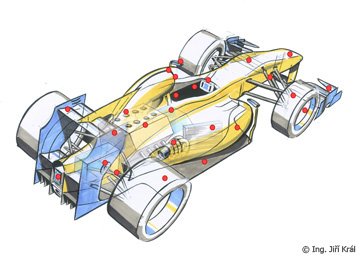Watch out for the overtakings at Suzuka, the track celebrating 30 years with Formula 1
Alessandra Fedeli/ Brembo | 3.10.17 | Brembo F1 brzdy
Brembo F1 2017
Brakes are used little during the Japanese GP
The Asian trilogy ends with the Japanese GP, which is the 16th race in the 2017 World Championship scheduled for October 6-8 at the Suzuka International Racing Course. Formula 1 debuted on this track 30 years ago, but it was in 1962 that the Honda-owned circuit was inaugurated.
Located in the Mie Prefecture city of the same name, the Suzuka International Racing Course has modified its configuration four times, most recently in 2003. That year it changed the layout of the 130R corner, which the drivers take at full throttle, and the chicane where the brakes are essential.
Like all tracks that are very drivable, Suzuka is full of fast corners that require almost insignificant use of the brakes. On Turn 8, the brakes aren't used at all (like on Dunlop) and on another five corners, the braking distance doesn't exceed 15 meters.
There are just a couple of hard braking sections where the cars drop more than 200 km/h. The victory could be up for grabs right at these points and to stay in the game, some drivers might extend beyond the braking limits and risk flying off the track.
According to Brembo technicians, who classified the 20 tracks in the World Championship on a scale of 1 to 10, the Suzuka International Racing Course is one of the least demanding on the brakes. The Japanese racetrack earned a difficulty index of 4, on par with Silverstone and Interlagos.
The demand on the brakes during the GP
The 18 corners on the track require drivers to use their brakes 10 times per lap, for a total of just over 13 seconds. Braking on Turn 5 lasts less than one second. From the starting line to the checkered flag, each driver uses his brakes for a total of 11.5 minutes.
The almost complete absence of thrilling braking sections means the average peak deceleration per lap is 3.3 G, the lowest in the championship. In Mexico City this figure is 3.4 G and in Shanghai it reaches 3.5 G. The similarity of these three numbers may be misleading however, because the Mexican track is a lot more challenging on the brakes and the Chinese circuit earned six points out of ten on the difficulty index.
Since there are few corners that require heavy deceleration, the energy dissipated in braking by a single-seater over the course of the entire GP is fairly contained: 109 kWh, which is less than half that of the Singapore GP. The load applied by each driver on the brake pedal throughout the race is also moderate: 44 metric tons, but this is still equivalent to more than three times the weight of all the Superbikes that competed in the last Suzuka 8 Hours.
The most demanding braking sections
Of the 10 braking points at Suzuka International Racing Course, none are classified as highly demanding on the brakes by Brembo technicians, but four are of medium difficulty and six are light.
The most challenging by far is Turn 16, where the cars go from 323 km/h to about 95 km/h in just 65 meters. During the 2.71 seconds when the brakes are operating, the drivers apply a load of 119 kg on the pedal and are subject to a peak deceleration of 4.4 G.
The load on the brake pedal is even heavier at the Degner Curve (Turn 9): 123 kg, but braking happens in less space (34 meters) and less time (1.45 seconds) because the single-seaters can take the corner going 147 km/h and so they drop only 114 km/h.
At the Hairpin (Turn 11), the gap in speed is back up to more than 200 km/h (from 282 km/h to 78 km/h) thanks to the brakes being used for 2.56 seconds and the cars traveling about 58 meters. However, there is less physical stress placed on the drivers: 3.6 G in deceleration and a 105 kg load on the brake pedal.
Brembo performance
Single-seaters with at least one Brembo component have won 19 of the 32 Japanese GP races that they took part in. A good seven of these victories were earned by Ferrari, but in the first edition back in 1976 in Fuji, Ferrari lost the World Drivers' Champion title that Niki Lauda seemed sure to win.
Ferrari hasn't won at Suzuka since 2004, but Sebastian Vettel took the top podium four times on this track with Red Bull. If he had one more victory to his name, he would match Michael Schumacher's record of being the only driver to have won five times at Suzuka with Brembo brakes.




